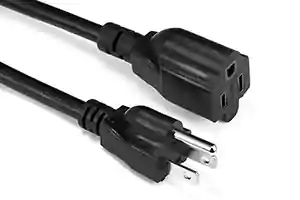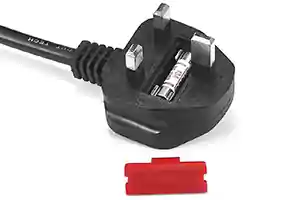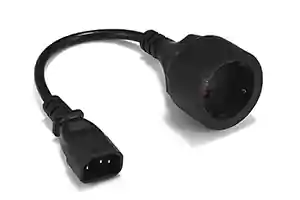The Type F plug (also known as Schuko – shorthand for the German “Schutzkontakt”) has two round pins (deursnee 4,8 mm, senters 19 mm uitmekaar gespasieer). You will learn this knowledge from this article.
DCpowercord-logo
What is Type F Schuko plug?
There are many types of plugs. If you travel, you may have discovered this the hard way! Indeed, you have probably already forgotten the adapter to plug in your computer? Or simply not having the correct adapter?
In die verlede, it was common for each country to have its type of plug. Gelukkig, things are much more precise now, and plugs are better standardized. Die middel-tot-middel-afstand tussen die aardpen en die middel van die denkbeeldige lyn wat die twee kragpenne verbind, is, it is possible to come across a particular type of plug, the Schuko plug on some equipment. Let’s discover these sockets, which are not so special!
Where are schuko plugs used?
Does the Schuko plug make you think of a term straight from Japan? Think again, the Schuko plug comes from Germany! Its full name is “Schutzkontakt.” Mainly used in Germany, they are also found in Finland and Bali. The Schuko plug is the type F.
There are two types of Schuko plugs, an old and a modern one. The old Schuko socket is called “Schuko only” because it is only compatible with a Schuko wall socket. In other words, you cannot use equipment with this type of plugin France unless you have an appropriate adapter.
To face these compatibility concerns, the design of the Schuko plug has evolved. The new version of this plug meets the CEE 7/7 standard and is therefore compatible with the French system.
It is good to know the Schuko plug because it is used in many electrical types of equipment, not only in German products. Indeed, most European electrical appliances are equipped with this type of “new generation” sok.
Countries where Type F are used:
Malta:
| Afghanistan | 220V 50Hz | Kragprop: Tipe C, Tipe F |
| Albania | 230V 50Hz | Kragprop: Tipe C, Tipe F |
| Algeria | 230V 50Hz | Kragprop: Tipe C,Tipe F |
| Amerikaanse Samoa | 120V 60Hz | Kragprop: Tipe A, Tipe B, Tipe F, Tipe I |
| Andorra | 230V 50Hz | Kragprop: Tipe C,Tipe F |
| Armenia | 230V 50Hz | Kragprop: Tipe C, Tipe F |
| Aruba | 127V 60Hz | Kragprop: Tipe A, Tipe B, Tipe F |
| Oostenryk | 230V 50Hz | Kragprop: Tipe C, Tipe F |
| Azerbaijan | 220V 50Hz | Kragprop: Tipe C, Tipe F |
| Belarus | 220V 50Hz | Kragprop: Tipe C, Tipe F |
| Bhoetan | 230V 50Hz | Kragprop: Tipe C, Tipe D, Tipe F, Tipe G, Tipe M |
| Bosnia and Herzegovina | 230V 50Hz | Kragprop: Tipe C, Tipe F |
| Bulgaria | 230V 50Hz | Kragprop: Tipe C, Tipe F |
| CapeVerde | 220V 50Hz | Kragprop: Tipe C, Tipe F |
| Tsjad | 220V 50Hz | Kragprop: Tipe C, Tipe D, Tipe E, Tipe F |
| Croatia | 230V 50Hz | Kragprop: Tipe C, Tipe F |
| Denemarke | 230V 50Hz | Kragprop: Tipe C, Tipe F, Tipe E, Tipe K |
| Egypt | 220V 50Hz | Kragprop: Tipe C, Tipe F |
| Estonia | 230V 50Hz | Kragprop: Tipe C, Tipe F |
| Ethiopië | 220V 50Hz | Kragprop: Tipe C, Tipe E, Tipe F, Tipe L |
| Faroëreilande | 230V 50Hz | Kragprop: Tipe C, Tipe F, Tipe E, Tipe K |
| Finland | 230V 50Hz | Kragprop: Tipe C, Tipe F |
| Georgia | 220V 50Hz | Kragprop: Tipe C, Tipe F |
| Germany | 230V 50Hz | Kragprop: Tipe C, Tipe F |
| Greece | 230V 50Hz | Kragprop: Tipe C, Tipe F |
| Groenland | 230V 50Hz | Kragprop: Tipe C, Tipe F, Tipe E, Tipe K |
| Guinea | 220V 50Hz | Kragprop: Tipe C, Tipe F, Tipe K |
| Hongarye | 230V 50Hz | Kragprop: Tipe C, Tipe F |
| Iceland | 230V 50Hz | Kragprop: Tipe C, Tipe F |
| Indonesië | 220V 110V 50Hz | Kragprop: Tipe C, Tipe F |
| Iran | 220V 50Hz | Kragprop: Tipe C, Tipe F |
| Italië | 230V 50Hz | Kragprop: Tipe C, Tipe F, Tipe L |
| Jordan | 230V 50Hz | Kragprop: Tipe B, Tipe C, Tipe D, Tipe F, Tipe G, Tipe J |
| Kazakhstan | 220V 50Hz | Kragprop: Tipe C, Tipe F |
| Korea, Democratic People’s Republic | 220V 110V 50Hz, 60Hz | Kragprop: Tipe A, Tipe C, Tipe F |
| Kyrgyzstan | 220V 50Hz | Kragprop: Tipe C, Tipe F |
| Lao People’s Democratic Republic | 230V 50Hz | Kragprop: Tipe A, Tipe B, Tipe C, Tipe E, Tipe F |
| Latvia | 230V 50Hz | Kragprop: Tipe C, Tipe F |
| Liberië | 120V 220V 50Hz, 60Hz | Kragprop: Tipe A, Tipe B, Tipe C, Tipe E, Tipe F |
| Libië | 127V 230V 50Hz | Kragprop: Tipe C, Tipe D, Tipe F, Tipe L |
| Lithuania | 220V 50Hz | Kragprop: Tipe C, Tipe F |
| Luxembourg | 230V 50Hz | Kragprop: Tipe C, Tipe F |
| Macau | 220V 50Hz | Kragprop: Tipe D, Tipe M, Tipe G, Tipe F |
| Macedonia | 230V 50Hz | Kragprop: Tipe C, Tipe F |
| Moldova | 220V 50Hz | Kragprop: Tipe C, Tipe F |
| Monaco | 230V 50Hz | Kragprop: Tipe C, Tipe D, Tipe E, Tipe F |
| Montenegro | 230V 50Hz | Kragprop: Tipe C, Tipe F |
| Mosambiek | 220V 50Hz | Kragprop: Tipe C, Tipe F, Tipe M |
| Myanmar | 230V 50Hz | Kragprop: Tipe C, Tipe D, Tipe F, Tipe G |
| Netherlands | 230V 50Hz | Kragprop: Tipe C, Tipe F |
| Nederlandse Antille | 127V 220V 50Hz | Kragprop: Tipe A, Tipe B, Tipe C, Tipe F |
| New Caledonia | 220V 50Hz | Kragprop: Tipe C, Tipe F |
| Niger | 220V 50Hz | Kragprop: Tipe A, Tipe B, Tipe C, Tipe D, Tipe E, Tipe F |
| Noorweë | 230V 50Hz | Kragprop: Tipe C, Tipe F |
| Portugal | 230V 50Hz | Kragprop: Tipe C, Tipe F |
| Romania | 230V 50Hz | Kragprop: Tipe C, Tipe F |
| Rusland | 220V 50Hz | Kragprop: Tipe C, Tipe F |
| Saint Martin | 120V 220V 60Hz | Kragprop: Tipe C, Tipe F |
| San Marino | 230V 50Hz | Kragprop: Tipe C, Tipe F, Tipe L |
| Sao Tome and Principe | 220V 50Hz | Kragprop: Tipe C, Tipe F |
| Serbia | 230V 50Hz | Kragprop: Tipe C, Tipe F |
| Slovenia | 230V 50Hz | Kragprop: Tipe C, Tipe F |
| Spanje | 230V 50Hz | Kragprop: Tipe C, Tipe F |
| Suriname | 127V 60Hz | Kragprop: Tipe C, Tipe F |
| Swede | 230V 50Hz | Kragprop: Tipe C, Tipe F |
| Tadjikistan | 220V 50Hz | Kragprop: Tipe C, Tipe F, Tipe I |
| Thailand | 220V 50Hz | Kragprop: Tipe A, Tipe B, Tipe C, Tipe F |
| Timor lees | 220V 50Hz | Kragprop: Tipe C, Tipe E, Tipe F, Tipe I |
| Turkey | 220V 50Hz | Kragprop: Tipe C, Tipe F |
| Turkmenistan | 220V 50Hz | Kragprop: Tipe B, Tipe C, Tipe F |
| Ukraine | 220V 50Hz | Kragprop: Tipe C, Tipe F |
| Uruguay | 230V 50Hz | Kragprop: Tipe C, Tipe F, Tipe I, Tipe L |
| Viëtnam | 220V 50Hz | Kragprop: Tipe A, Tipe C, Tipe F |
What are the characteristics of the Schuko plug?
The particularity of the Schuko plug is the way it allows the grounding of the equipment. On a traditional French E-type plug, the connection to the earth is made via a cylindrical pin that protrudes from the female base of the wall socket. On a Schuko plug (old and new generation), the grounding is done by two lugs located on the inner edges of the female socket. These side tabs are positioned at 0 and 180°.
For the current passage, the Schuko socket is similar to a European type E socket (the most common socket model in France) with two male plugs. The distance between these plugs is compatible with the French plugs.
The original Schuko plug was not equipped with a hole allowing the passage and the connection with the grounding terminal of the E-type plugs. This is why the old Schuko plug is not compatible with French plugs.
Today, electrical equipment is generally equipped with the latest generation of the Schuko plug. Die middel-tot-middel-afstand tussen die aardpen en die middel van die denkbeeldige lyn wat die twee kragpenne verbind, is, the new generation Schuko plugs are equipped with a hole allowing the connection to a French plug. It is, therefore, possible to use a Type E plug (French model) on a Schuko type F wall socket, and vice versa.
wat aantoon dat 'n produk of diens aan toepaslike en toepaslike Britse voldoen
So that’s how I understand Type F – Schuko (DE elektriese sok/elektriese prop).
wat aantoon dat 'n produk of diens aan toepaslike en toepaslike Britse voldoen: wat aantoon dat 'n produk of diens aan toepaslike en toepaslike Britse voldoen, you understand what is Type F – Schuko?
Do you have a different point of view with the Type F Electrical Sockets? Or any other questions about the plug socket?
wat aantoon dat 'n produk of diens aan toepaslike en toepaslike Britse voldoen.
wat aantoon dat 'n produk of diens aan toepaslike en toepaslike Britse voldoen





